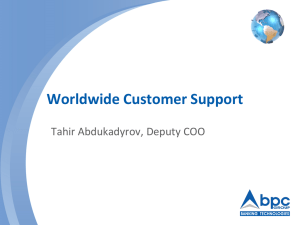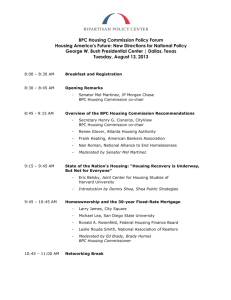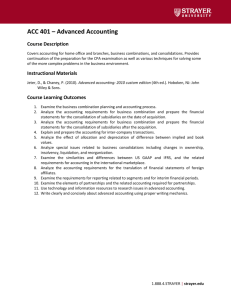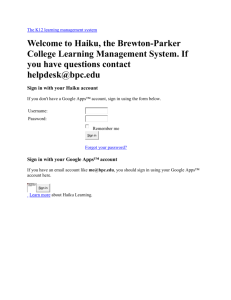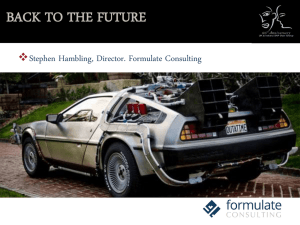Owens Corning Financial Consolidation Migrating from
advertisement
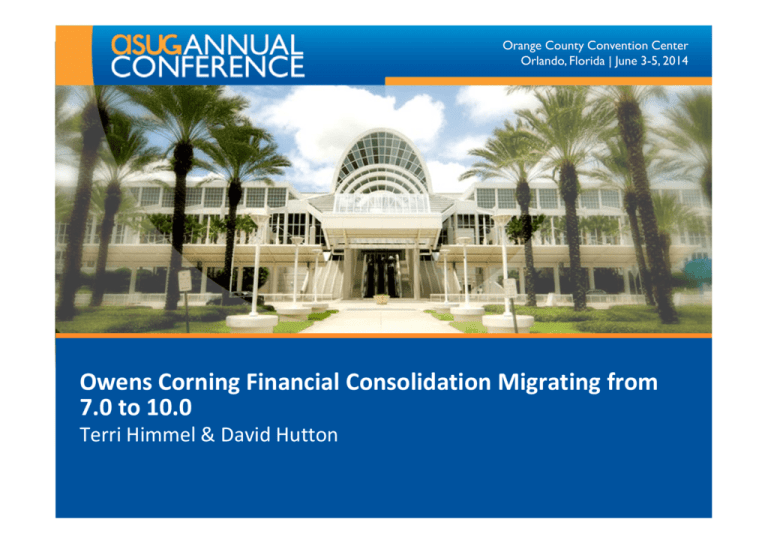
Orange County Convention Center Orlando, Florida | June 3-5, 2014 Owens Corning Financial Consolidation Migrating from 7.0 to 10.0 Terri Himmel & David Hutton Abstract Hear why Owens Corning decided to migrate the consolidation from BPC 7.0 – 10.0 Review the business case for changing the business model to a Group Based Financial consolidation Learn about some of the “Key Design Decisions” that were made during the project Hear about the decision to remove some custom development and justification to add some more Hear how OC leveraged the cloud to accelerate their technical migration Understand the performance metrics of an E2E consolidation from four source systems (7.0 v 10.0) Who is Owens Corning? Owens Corning Corporation is the world's largest manufacturer of fiberglass and related products. It was formed in 1935 and spun off independently in 1938. Fortune 500 Company for 59 consecutive years Sales of $5.3 billion in 2013 Approximately 15,000 employees 27 countries Five continents Credit: Owens Corning Who is Owens Corning? OC invented glass fiber and glass fiber insulation in 1938; split into two major business segments: Composites OC glass fiber materials can be found in over 40,000 end-use applications Building Materials Roofing Insulation Sound insulation / Acoustic Solutions Basement finishing solutions Credit: Owens Corning OC Has Been to the Moon Apollo 7 astronauts dressed in and slept on Beta cloth material First Moon vehicle equipped with Fire Safe Fiberglass Beta material Personal photos taken at OC Museum, WHQ in Toledo Speaker Introductions Terri Himmel (Owens Corning) Finance Center of Excellence Leader Led OC through both installations of BPC (7.0 and 10.0) 9 years of Owens Corning experience Dave Hutton (TruQua) BPC Consolidations Consultant 17 years of SAP Consolidations experience Agenda 5. Benefits 4. Project Realization 3. Key Design Decisions 2. Consolidations Wish List 1. Existing Pain Points SAP Legacy Evolution of OC consolidation solutions follows SAP’s history of products: FI-LC (circa 1900) EC-CS (1996 - 1997) BPC 7.0 (2008) The bleeding edge of technology Generally available in Q2/2009 Plus numerous source systems (4 currently) This is a file from the flickr Commons, credit:flickr.comphotosmecklenburg/ Operational Challenges Consolidate results from +-3800 entities 4 hierarchies 1. 2. 3. 4. Management Legal Geographic Tax Fast close (3 days) Numerous consolidations during close 4 SAP source systems Small team (centralized) This is a file from the flickr Commons, credit:flickr.com/photos/tantrum_dan/ Hierarchy Complexities Emerged from bankruptcy with sophisticated legal structure Constantly evolving management structure Building Materials Insulation Markets / Channel Customers Regions Vertical Integration Capital Products Plant Operations Distribution Warehouses Res EIS Drive Org Structure R&A Foam Rebates North America High Continuou s Drive Org Structure Discontinuous Many Composites Reinf ES NonWoven s Fabrics Americas, Asia, Europe High Drive Org Structure Continuou s Discontinuous BPC 7.0 Pain Points Entity Hierarchies 1. 2. 3. 4. Management Legal Geographic Tax Creating new hierarchies is labor intensive Security impact Entities Profit centers 3800 dimension members 14 hierarchy levels Nine Hierarchies Management reporting requires new hierarchy each year BPC 7.0 Pain Points Dimension members Obsolete members Leading zero’s Data Visibility IBM DataStage (custom development) “US Eliminations” Reconciliation Functionality “US Eliminations” Intercompany reconciliation This is a file from Getty Images BPC 7.0 Pain Points Undocumented functionality Customization (ABAP) IBM DataStage – source data mapping / logic Consolidation time is longer than desired 80 minutes for the first execution 60 minutes subsequently ? BPC 7.0 Pain Points Reporting Slow execution on large reports with multiple tabs Formatting of reports is labor intensive No ability to report on lower levels of data Lack of ability to copy current application into quality assurance system Agenda 5. Benefits 4. Project Realization 3. Key Design Decisions 2. Consolidations Wish List 1. Existing Pain Points Dreaming Big Intuitive Fast Transparent Maintainable This is a file from Flickr commons Credit: flickr.comphotoshavro This is a file from Getty Images BPC 10.0 Wish List Make hierarchy maintenance easy Make intercompany eliminations better Provide insight into the data Adjustments, translations and eliminations Data loads from sources Improve consolidation execution times Utilize standard functionality Improve report performance Remove obsolete master data Agenda 5. Benefits 4. Project Realization 3. Key Design Decisions 2. Consolidations Wish List 1. Existing Pain Points “Elim Entities” versus “Groups” Eliminations on “groups” more intuitive Still maintained entities but made them time-dependent Entity Dimension Group Dimension Entity Dimension The Side Effect of Using “Groups” Financial Model “Elim Entities” TruQua migration and maintenance tool Ownership Model “Groups” Business Rules configuration change from “US Eliminations” to more advanced “Eliminations and Adjustments” Consolidation Model “Groups” SAP BW InfoProvider “Time-dependent groups” Time-dependent master data and transaction data history to overcome “PARENT_GROUP” limitations Eliminations: Weighing The Value of ‘To Be’ “Elim Entities” “Group” Key Design Decisions Consolidation Model Time-dependent entity hierarchies Eliminated security maintenance Streamlined master data maintenance Minimized change management impacts More details for auditability Replace customization with standard functionality Almost all Data Manager packages were custom in 7.0 Replaced IBM DataStage with standard SAP BW pre-delivered content This is a file from the flickr Commons credit: flickr.com/photos/radialmonster/ Agenda 5. Benefits 4. Project Realization 3. Key Design Decisions 2. Consolidations Wish List 1. Existing Pain Points Using the Cloud for Project Acceleration TruQua Cloud Environment Security: • SAP SNC • Encrypted DB • Dual Factor Authentication BPC 7.0 / BW 7.01 BPC 10.0 / BW 7.31 Client SAP Environment Building a Better Solution End-to-end “lights-out” automation SAP ERP and SAP BW data loads Consolidations (e.g. currency translation and eliminations) Generation of the group hierarchy and ownership data from time-dependent entity hierarchies Capturing records with bad or obsolete master data Automated data validations (i.e. debits equal credits) Automatic e-mail notifications Enhanced reporting and analysis Document line item drill-through Credit: Owens Corning Optimizing Performance Sizing hardware Making operating system changes Applying Oracle database patches Configuring SAP NetWeaver Re-designing and reconfiguring BPC Use of the “Parallel Execution Framework” P P P Agenda 5. Benefits 4. Project Realization 3. Key Design Decisions 2. Consolidations Wish List 1. Existing Pain Points Performance Metrics Task BPC 7.0 (mins) BPC 10.0 (mins) Load from Source - 4 ERP systems // 30 10 Translate and eliminate 30 Currency Translation 10 Net Income (script) 1 Eliminations 10 Total Time 60 31 Data Volumes (monthly) BPC 7.0 (recs) BPC 10.0 (recs) Group None 220K Legal 1.9M Management / tax / Geographic 3.5M Total 800K 5M Reporting Impacts Performance 2x to 20x faster Usability Very similar but formatting is much easier Maintenance Had to learn a new Excel add-in tool and re-write all reports Performance and Usability Maintenance Business Benefits Transparency to data from source systems Ability to reconcile between SAP and BPC Automated processes Reporting performance Drill through capability Automated data validations This is a photo from Flickr commons Credit: flickr.comphotosphotorisma FOLLOW US THANK YOU THANK YOU FOR PARTICIPATING Please provide feedback on this session by completing a short survey via the event mobile application. SESSION CODE: 1609 For ongoing education on this area of focus, visit www.ASUG.com
